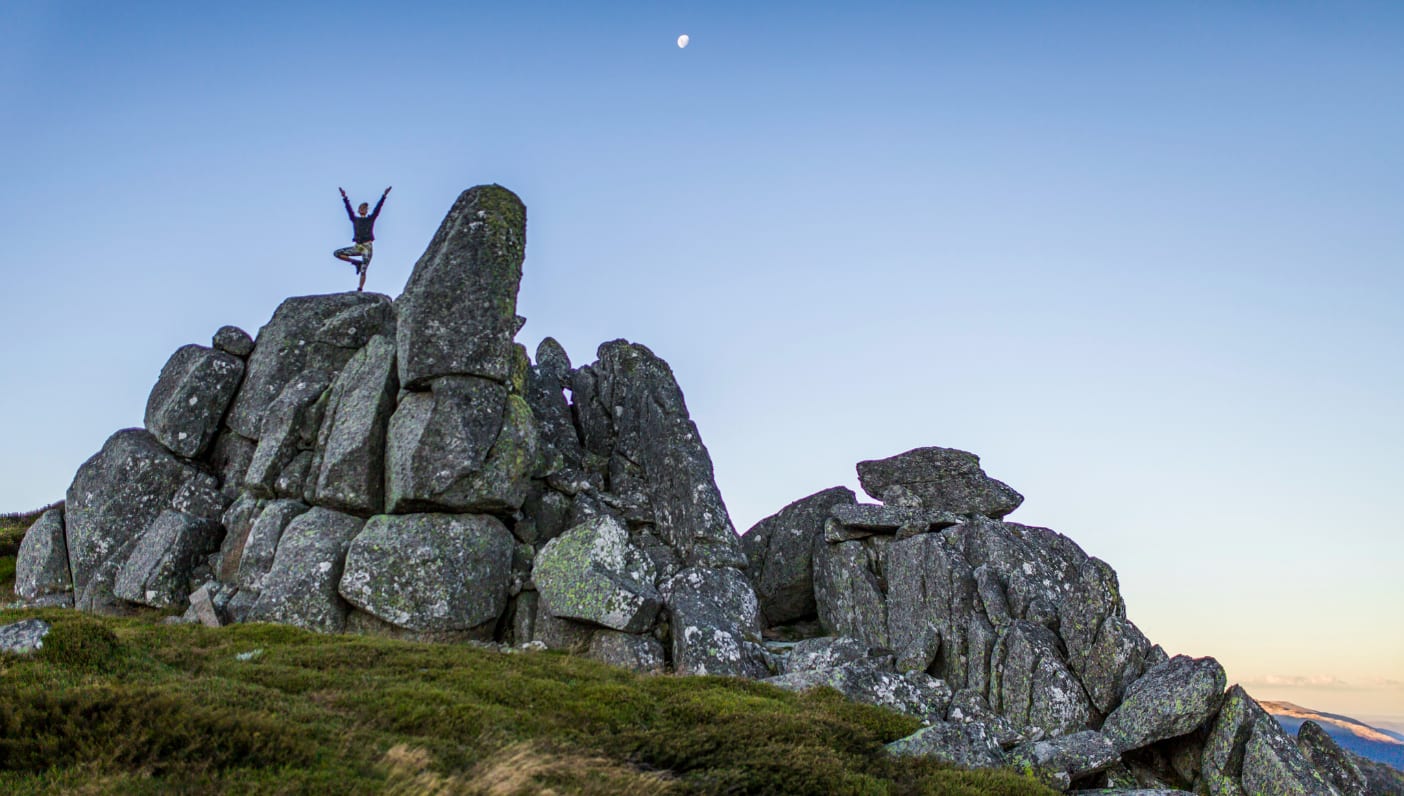
Mountains make up nearly one quarter of the world’s surface—not that we see many of the mountains that exist. The largest range is deep in the Atlantic Ocean, some 25,097 miles long, and there the peaks are 8,200 feet below sea level.
In the most direct sense, mountains are born out of the Earth—from the molten rock escaping from its core, or from the colliding of the tectonic plates of the Earth’s crust—and it is perhaps this reason that when we walk along their trails we feel a deep sense of peace or connection. Our feet are touching the very heart of the Earth in those moments, and we feel grounded.
It is this essence that we tune into in our Tadasana, Mountain Pose, as we root our feet down into our mats to form a steady base from which we can rise up. When we hold this asana we invoke in us the same solid, serene energy of the mountains.
When we walk along their trails we feel a deep sense of peace or connection.
But there is something else we receive in our time spent in the mountains. There is the silence, and the clean air, but there is also a feeling of being close to the Divine—because in addition to connecting us to the Earth, mountains, with their towering summits, also connect us to the heavens. Some are considered sacred such as Croagh Patrick in Ireland, Machapuchare in Nepal, Arunachala in India, Mount Kailash in Tibet, Mount Shasta in the US, Machu Picchu in Peru, and Wǔdāng Shān in China. At these mountains it is said the Divine is present and that miracles occur.
Even without miracles, there is a quality that comes with spending time on any mountain. Whether we are walking or climbing, says Reverend Philip Parker, mountains both ground us, and inspire us. “We are affected—uplifted—by them, and we firmly believe the effect to be a good one, though we cannot explain why,” he says. Many mountaineers return citing mystical experiences, or with a sense inner clarity, humility, or acceptance.
Perhaps this wisdom and inspiration we feel in their presence is because they spend their lifetimes reaching ever upwards. Mountains can spend millennia beneath the sea like the Mid-Atlantic Ridge, before eventually emerging and continuing their journey above the water. Mount Everest towers some 29,029 feet above sea level.
The parallels with our own evolution become apparent. Mountains become our guides. In many traditions and religions mountains not only serve as spiritual teachers, but the climb up to the summit is compared to our own individual spiritual development. Like our path of yoga, there will be challenging moments where we will be terrified, but there will also be soaring moments when we rest in awe. Like scaling a mountain, it is through faith, commitment to the path we are on, and perseverance in the face of challenges that will ensure we eventually reach our summit—an awakened heart.
The mountains therefore provide us with a perfect setting for yoga. Here are some ideas for bringing our practice to the mountains.
1. Utthita Hasta in Tadasana
Here we ground the feet down into the earth to form the base of our mountain, but we slowly raise the arms up above the head to connect us to the heavens. Keeping our focus fixed on the palms we seek to draw energy down from our « peak » into our base, If we are feeling very secure and grounded in our base we can also engage Ashwini mudra, the mudra of the horse, to keep the energy within.
2. Prana Mudra
Energy healer Divya Prasad says simplest way to connect with nature she says is to “bring yourself to an awareness that everything is energy, including us.” She suggests rubbing the palms together and drawing them close to feel the energy between the palms. She also recommends 10 different mudras for the mountains. Prana mudra connects us to the life force that we share with the mountain, activating dormant energy in the body, says Prasad. Simply join your ring fingertip and little fingertip to your thumb tip.
3. Dirga Pranayama
The three-part breath allows us to follow the path of expansion within our own body—similar to our climb up a mountain—and also allows us to take a deeper breath, which can be helpful in high altitudes. Start by filling only the belly with breath, feeling it rise on the inhale and sink towards the spine on the exhale, as we begin to form the base of our breath.
On our next inhale we fill the belly, but we also continue breathing in until we feel the ribs expand outwards to the sides. Then we exhale feeling the ribs collapse back together, and the breath continue its exit our of the belly. Finally on our next inhale we fill the belly, then the ribs, and continue breathing in and upwards to the collarbone until we sense the very tops of our lungs being filled. This is the peak of our inhale, before we let the breath slowly leave in the opposite direction until we empty our base. Dirga pranayama is a very deep and cleansing breath that can help purify the lungs.
4. Meditation
Our mind naturally stills when we are in nature, which makes it a perfect time for a meditation. Here is a specific meditation on the mountains, which involves reconnecting with the environment around you in order to nourish your soul.
—

Helen Avery is a senior writer for Wanderlust Media. She is also a journalist, writer, yoga teacher, minister, and full-time dog walker of Millie, residing in Brooklyn, New York. You can find out more about her on her website, Life as Love.